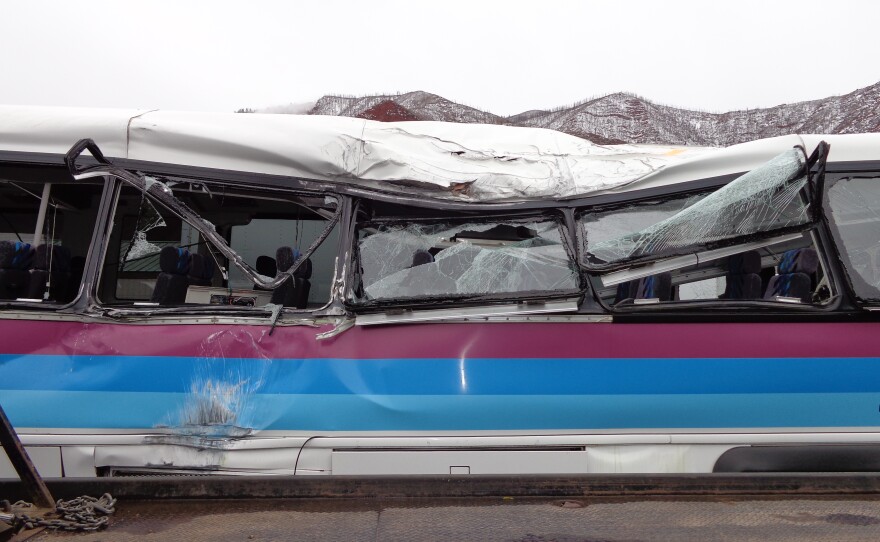Seat belts could have prevented major injuries in October’s major bus crash near Carbondale. A Roaring Fork Transit Authority bus rolled onto its side, sending at least ten people to the hospital. Less a month later, the federal government decided to require seat belts in exactly the kind of bus that wrecked. The requirement won’t start until 2016. In the meantime, an internal investigation and county traffic court are delving into what happened the night of the accident.
Amelia Eshelman barely missed the RFTA accident. Eshelman was driving from El Jebel to the Carbondale area just before the wreck was reported. Driving West on Highway 82 in her Volkswagen beetle, Eshelman had to make a quick lane change around a slow moving vehicle.
Amelia Eshelman: “When I was driving down, I noticed a very light red flashing light, with another light below it. In my mind I thought: ‘Motorcycle? This is kind of odd.’ And all of sudden I was literally on top of it."
This is Eshelman giving a statement to the Garfield District Attorney's office.
Eshelman: “I swerved around it to the left, and I caught out of the corner of my eye, additional red lights. So I realized at that point that it was an actual vehicle, like you know I saw it was a tractor.”
The vehicle was a John Deere utility tractor, with a mower attached to it… likely the same one the RFTA bus had to swerve around to avoid just moments later. Eshelman turned off the highway before the bus crashed into a concrete barrier. Her statement is now part of a report on the crash by the Colorado State Patrol. It includes hair-raising accounts from the bus passengers.
Passenger Catherine Anthon, read by Collins Kelly: “I know that the bus flipped and and at that point somehow I definitely crashed into the window. I know [the] window did not fully break so my body was outside [the] bus. I attempted to move my legs out of the way of the bus and I couldn’t move fast enough and the bus landed on my right leg.”
Passenger Karla Miller, read by Cornelia Carpenter: “Passengers (including me) got thrown from the bus. I injured my right knee and my ribs on my right side. I ended up crawling away with some help from another passenger, who helped lift me and helped me to a rock to sit on nearby [the] bus accident. I’m very lucky to be alive.”
Passenger Maggie Fricke, read by Collins Kelly: "Then someone yelled “Hang on!” Then the bus slammed down on the left side - where I happened to be sitting. The next thing I knew, I was laying in brush with the bus window pinning me to the ground. The glass was broken and ballooned out. My legs were against the guardrail and the window was pinning me halfway; my hips and upper body on one side, my lower hips and legs against the guard rail.”
All the passengers survived. Still, they were injured, some severely and many of their injuries might have been prevented if the passengers had been wearing seatbelts… which the bus does not have in regular seats. Only the driver was belted-in. He told state troopers, quote, “my seatbelt saved me from flying through the windshield.”
Weeks later, the federal government decided that new busses like the one in the RFTA crash must have seatbelts in 2016. RFTA's CEO, Dan Blankenship says while the agency is aware of the new rule, and despite the crash, there is no plan at the moment to start buying those new busses.
Dan Blankenship: “Right now our fleet is relatively young, maybe an average life of six years or so, and we most likely begin replacing all the busses that we have in our fleet until we get to 2020.”
RFTA has considered adding seat belts before then. The issue came up at a board meeting in November, after the crash. One problem is funding. Retrofitting busses is expensive, around forty thousand dollars a bus. There are also liability concerns with after-market seat belts.
Blankenship: “The floors have to be replaced and the structure has to be strengthened and so forth to be able to ensure that when there’s an accident that with people strapped into the seats the seats themselves won’t become projectiles.”
Reporter: The bus in the October crash was totaled. RFTA is replacing it, with one that has seat belts if one is available. Beyond that, in the wake of the wreck, RFTA is also considering systems that warn drivers of impending collisions.
In the meantime, RFTA and its insurance agency have hired an accident investigation specialist, to reconstruct what happened on October 26th. While the driver was not cited, CEO Dan Blankenship acknowledges there still could be lawsuits filed. Because of that, RFTA denied Aspen Public Radio’s request to view camera footage of the crash.
Blankenship: “Some of the injured have sought representation and we have received notices of claims from six passengers so far, and then most cases the attorneys have advised us not to contact these people directly.”
As for the driver of the tractor, the thirty six year old man from Snowmass is facing a traffic infraction. His tractor and trailer didn’t have legal signage warning other drivers he was moving well below the speed limit. If found guilty, he could pay up to two hundred dollars.






















